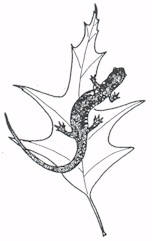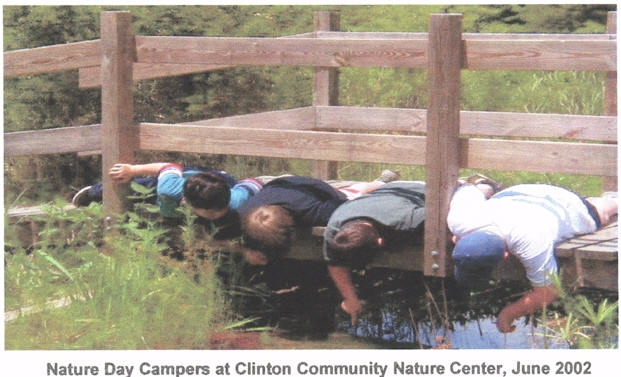
Clinton Community Nature Center
P. O. Box 93
Clinton, MS 39060
601-926-1104
March 20, 2003
 |
Clinton Community Nature Center P. O. Box 93
March 20, 2003 |
|
Director Nellie Neal
Environmental Educator Officers Committee Chairmen
e-mail:
|
Proposal for NANFA’s Gerald C. Corcoran Education Grant The Clinton Community Nature Center respectfully requests funding for a new exhibit and lab activities, ‘Get to Know Native Fishes’. The Center will account for all monies, report as requested by NANFA, and gratefully acknowledge NANFA in all publications and in the exhibit. Project Title: Get to Know Native Fishes Applicant’s Name:
Nellie Neal, Director
|
|
 |
Summary Statement
‘Get to Know Native Fishes’ will successfully address two of NANFA’s objectives. By developing an exhibit including native fish species and a kiosk to interpret them, the Clinton Community Nature Center will ‘increase and disseminate knowledge about North American native fishes and their habitats’ and promote their ‘conservation.., and protection/restoration of natural habitats’ to more than 15,000 visitors from all walks of life annually. With the addition of a nature lab featuring native fish to our ‘Buddy Kit’ program, we will provide hands-on experiences with these fascinating species to teachers and students in grades 2-8 who visit the Center on field trips. By making our program available to other organizations, we hope to encourage their interest in native fishes.
Educational Objectives
1) demonstrate ways to restore and protect habitat to foster native fish
populations
2) create exhibits and activities that will spread knowledge and awareness
of native fish species to students, teachers, organizations similar to ours,
and the general public
3) provide study opportunities to increase our community’s knowledge base
about native fishes
Target Audience
The target audience for the project is the 15,000 people of all races and ages who visit the Center each year. They include summer day campers, people who attend any of our ten ongoing environmental education programs, teachers and students of all ages, Scouts, senior citizens, and trail walkers. In 2002, visitors came from 22 different states, as far away as Canada, and as close as the neighborhood around the Center.
Within the target audience is an important subset, teachers and students in grades 2-8 who visit the Center on field trips and use our 33 acres as their outdoor laboratory. Our goal is to provide hands-on experiences for the students and training and resources for their teachers, and we have made significant steps towards it. The Teacher Connectivity Project will bring more than forty teachers to the Center for environmental education workshops and the introduction of Buddy Kits. The kits are designed for pairs of students to use as they explore the Center’s natural features and learn basic scientific methods of research and reporting. Three themes have been introduced - biology, earth science, and urban forestry - and each is available in three age-appropriate formats suitable for grades 2-3, 4-6, and 7-8.
By presenting our methods and process in the form of a report delivered in person, in print, or via the internet, we will reach an even broader audience of environmental educators and native fish enthusiasts, and hopefully inspire them to create similar exhibits and lab activities.
Project Description
‘Get to Know Native Fishes’ has four components which will work together to conserve habitat, promote awareness, and spread information about native fish species in our environment and beyond. With the recent installation of a fresh water well and artificial spring to enhance the Center’s pond habitats, we are now prepared to create an outdoor exhibit featuring native fish species. The well was funded by US Fish and Wildlife Service, LMRCC-Aquatic Resources Management Plan as an essential part of our ongoing work to restore the habitat that is the Center’s 33.3 acres by providing a source of nonchlorinated water for plants and wildlife.
1) This project will introduce native fish species to the Center’s small ponds to allow our visitors to observe them and us to learn more about restoring and protecting their habitat. Butterfly Garden Pond has a healthy population of mosquito fish (Gambusia affinis); we will introduce pygmy sunfish (Elassoma zonatum) and other small species or minnows with this project.
2) We will design and construct an interpretive kiosk exhibit to focus on native fish of this area. It will include a small deck and feature colorful, permanent displays of information about fish native to our state and region, including those in our ponds. Five such kiosks are already in place along the Center’s trails built by talented volunteers who will donate their expertise to design and construct a high quality, attractive exhibit.
3) ‘Buddy Kits’ nature labs will focus on identification, ecology, and conservation of native fish species with hands-on activities for students in grades 2-8. The kits in our existing program are adapted to three age groups. The program includes enough lab kits for 15 pairs of ‘buddies’ (or a class of 30) to study urban forestry, basic biology, or earth science in one session.
4) We will produce a handout with more information about native fish species, and make it available on request at no charge in our classroom building, and we will prepare information about the completed project for dissemination to other interested organizations.
Educational format
The educational format for ‘Get to Know Native Fishes’ will include informal and formal learning opportunities for people of all ages who visit the Center and those we teach about its methods and activities at other locations. One can look at the fish while walking the trails and admire their beauty, then read more about them in the kiosk exhibit and pick up a handout at the information station in the gift shop. A. group of teachers and environmental educators will attend a workshop at the Center, then bring their classes to conduct nature lab activities or invite us to share our experiences with their school or nature center. A church group might take a tour including a presentation about this exhibit, then let our experience be their guide to including native fishes in a pond at their church garden. We will reach our target audiences with this combination approach: every visitor can see the exhibit and learn about native fish, schoolchildren can learn more with hands-on lab activities, and groups and other organizations can get in-depth information about the fish and the project and benefit from our experience.
Planned site(s)
A classroom aquarium exhibit of native fishes has fascinated adults and children at the Nature Center for two years. That site will be maintained and information about it will be included in the materials produced with this grant. The new project will be conducted in the classroom and by the ponds with a ‘Get to Know Native Fishes’ kiosk exhibit and deck to facilitate habitat study. When the project is completed, we will be better able to promote awareness of native fish species and inform the public about protecting their habitat. As we disseminate our methods and results via the internet and conferences, the project’s site will become those venues.
Lifespan of project
The project will take eight months to complete as outlined in the timeline below, and will be a permanent feature of the Center thereafter.
Expected outcomes
1) The native fish species introduced to the Center will thrive in its habitat; their reproduction will offer us more learning opportunities.
2) Casual visitors to the ‘Get to Know Native Fishes’ exhibit will increase their awareness of native fish species and will register their interest by seeking more information from us about the subject.
3) Teachers and students will use lab activities developed by the Center to study native fish in greater depth and learn to promote their conservation.
4) The project will become a model for similar organizations to encourage their efforts to increase and disseminate information about native fish species.
Environmental education for visitors of all ages at the Center includes monthly programs, teacher training, summer day camps, and school field trips, as well as 2.5 miles of trails with labeled plants and historic features. Every aspect of our educational program will be enhanced by the successful completion of this project. Perhaps most important to NANFA’s mission and ours, the next generation of citizen scientists will be inspired to promote conservation of native fish species.
Evaluation methods
Each nature lab activity offered at the Center includes an evaluation form for teachers, students, and campers to provide reactions and feedback for improvement. In addition, as a component of the Center’s Environmental Education program, the entire project will be evaluated by the Biodiversity Committee, led by a member of the Board of Trustees.
|
Timeline Month, 2003 September October November January Feb-Mar April May |
|
|
Budget Item Fish Buddy Kits nature labs Fish observation trap tank Kiosk exhibit* |
Description will collect locally 45 kits @ $9ea lumber and materials |
Amount 0 395 100 505 |
| Total Requested | $1000 |
* Design and labor to build the kiosk exhibit will be donated by Center volunteers.
Cooperating Individuals
Dr. Bill Stark, Chairman of the Biodiversity Committee, will oversee introduction of native fish species to the Center, review
the project, and evaluate it as it proceeds. He is Professor of Biology at Mississippi College, an Aquatic Entomologist who also teaches vertebrate systematics.Dr. Prentiss Cox, Center President, will oversee the project, be its financial officer and oversee exhibit construction. He is retired from Mississippi College as Professor Emeritus of Biology.
John Broussard, Environmental Educator at the Center, will develop and implement the project’s lab activities. He retired after 25 years as a classroom biology teacher in 2001 and works part-time for the Center.
Nellie Neal, Center Director, will collaborate on the exhibit’s design and display, provide administrative support for
the project, prepare and disseminate reports and project replication materials.